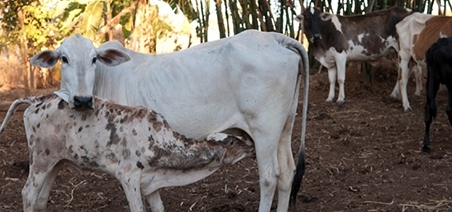

Brazilian researchers found that early biochemical interactions between the embryo and uterus may be fundamental for avoiding miscarriages in cattle (photo: Eduardo Cesar / Pesquisa FAPESP)
Brazilian researchers found that early biochemical interactions between the embryo and uterus may be fundamental for avoiding miscarriages in cattle.
Brazilian researchers found that early biochemical interactions between the embryo and uterus may be fundamental for avoiding miscarriages in cattle.

Brazilian researchers found that early biochemical interactions between the embryo and uterus may be fundamental for avoiding miscarriages in cattle (photo: Eduardo Cesar / Pesquisa FAPESP)
By Elton Alisson | Agência FAPESP – Between 20% and 40% of pregnancies in beef cattle miscarry in the embryonic stage, according to current estimates. The causes of mortality and the factors that affect the survival of embryos and the continuity of pregnancy in bovines are not fully understood.
A study conducted by researchers at the University of São Paulo (USP) in Pirassununga, Brazil, in collaboration with colleagues at the University of Florida in the United States and the University of Antwerp in Belgium, shows that biochemical communication between embryo and uterus may be fundamental to guarantee ideal development and successful establishment of pregnancy in cows.
The study was supported by FAPESP. Results are published in Scientific Reports.
“We found that biochemical communication between the embryo and the uterus takes place much earlier than was thought, on the seventh day of gestation,” Mário Binelli, a professor at the University of Florida and principal investigator for the project, told Agência FAPESP.
“In this stage of development the embryo already has the capacity to change the biochemical composition of the uterine environment, and these changes probably benefit embryonic development.”
According to Binelli, in the embryonic stage of bovine pregnancy the embryo transits from the uterine tube (oviduct) to the uterine lumen, where it remains loosely attached for a period of 20 days until implantation and the start of placentation.
This period is critical for the pregnancy: 40% of embryos die at this stage. After implantation, embryo mortality decreases as the embryo receives nutrients from the placenta.
The hypothesis that the embryo might influence the uterus at the start of the pre-implantation stage had never been considered before, not least because at this stage the bovine embryo is tiny – it has 100-200 cells and is about 200 micrometers in diameter.
“The prevailing idea was that at this stage the embryo passively received nutrients and stimuli from the maternal reproductive tract, taking no action of its own,” Binelli said.
Another recent study performed by the same group of researchers showed that the embryo’s presence on the seventh day of the gestation changes the transcription of certain genes in the reproductive tract. They then decided to find out whether the embryo could not only modify gene transcription but also release signals capable of changing the biochemical composition of the uterine environment so as to assist its own development.
To test this hypothesis the researchers focused on certain molecules believed to play a key role in bovine gestation, measuring the levels of these molecules in the endometrium (the mucous membrane that lines the inside of the uterus) of inseminated cows detected pregnant seven days after estrus, and comparing them with non-inseminated (and hence not pregnant) cows.
The results of the analysis showed that the presence of the embryo on the seventh day of gestation raised the levels of lipoxygenase-derived metabolites and lowered levels of amino acids, biogenic amines, acylcarnitines and phospholipids in the endometrium of the inseminated cows.
Lipoxygenases are a family of enzymes involved in metabolizing prostaglandins and other eicosanoids required in pregnancy. Phospholipids play a key role in the regulation of cell function and signaling. Acylcarnitines are important to fatty acid transport and energy metabolism.
“We observed that there may possibly be a series of biochemical interactions between the developing embryo and the uterus that may be more or less ideal to meet the needs of the embryo and enable successful completion of the pregnancy,” Binelli said.
“Advances in the knowledge of the ideal conditions for embryonic development during this initial stage, when a large proportion of pregnancies are lost, have raised the productivity and profitability of cattle breeding.”
In vitro embryos
According to Binelli, the findings of this study may help enhance in vitro bovine embryo production, in which Brazil is world leader.
Albeit successful, the technique still has flaws. “There are many losses of embryos, probably because we aren’t yet able to mimic in vitro – outside the animal’s reproductive tract – what happens in vivo in the bovine uterus. As we advance in characterizing the ideal uterine environment for embryonic development, it will be possible to mimic these conditions in vitro,” said Mariana Sponchiado, first author of the article. Sponchiado developed the study during her ongoing doctoral research at the University of São Paulo (USP) and the University of Antwerp.
The Scientific Reports article “The pre-hatching bovine embryo transforms the uterine luminal metabolite composition in vivo” by Mariana Sponchiado, Angela M. Gonella-Diaza, Cecília C. Rocha, Edson G. Lo Turco, Guilherme Pugliesi, Jo L. M. R. Leroy and Mario Binelli can be read at: www.nature.com/articles/s41598-019-44590-9.
Republish
The Agency FAPESP licenses news via Creative Commons (CC-BY-NC-ND) so that they can be republished free of charge and in a simple way by other digital or printed vehicles. Agência FAPESP must be credited as the source of the content being republished and the name of the reporter (if any) must be attributed. Using the HMTL button below allows compliance with these rules, detailed in Digital Republishing Policy FAPESP.





